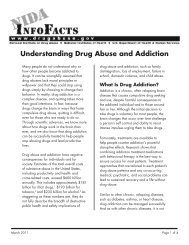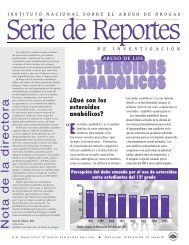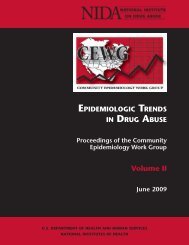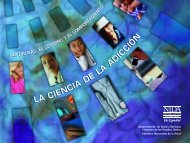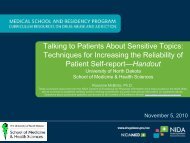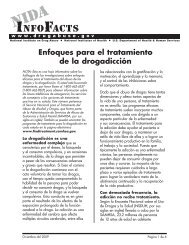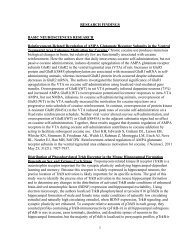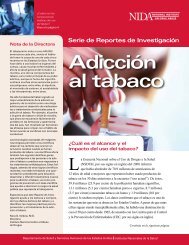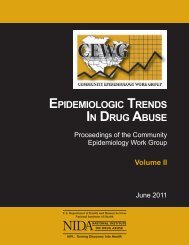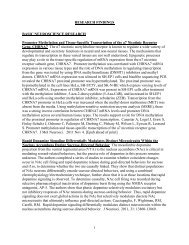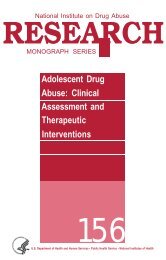CEWG January 09 Full Report - National Institute on Drug Abuse
CEWG January 09 Full Report - National Institute on Drug Abuse
CEWG January 09 Full Report - National Institute on Drug Abuse
Create successful ePaper yourself
Turn your PDF publications into a flip-book with our unique Google optimized e-Paper software.
EpidEmiologic TrEnds in drug AbusE: HigHligHTs And ExEcuTivE summAry<br />
Marijuana/Cannabis<br />
• Percentages of primary marijuana treatment admissi<strong>on</strong>s, including primary alcohol admissi<strong>on</strong>s,<br />
were highest in the first half of 2008 in Cincinnati (30.2 percent), followed by Miami/Dade County<br />
(26.9 percent), and Denver (24.3 percent). The lowest proporti<strong>on</strong>s of such admissi<strong>on</strong>s were in<br />
Bost<strong>on</strong> (3.1 percent) (table 11; appendix table 1).<br />
• Marijuana did not rank first as the primary drug problem in total drug admissi<strong>on</strong>s (including<br />
alcohol admissi<strong>on</strong>s) in any <str<strong>on</strong>g>CEWG</str<strong>on</strong>g> area; however, marijuana ranked sec<strong>on</strong>d in 8 of 21 <str<strong>on</strong>g>CEWG</str<strong>on</strong>g> areas,<br />
covering all four regi<strong>on</strong>s (secti<strong>on</strong> II, table 2).<br />
• Cannabis/marijuana ranked first in frequency in the proporti<strong>on</strong> of drug items identified in<br />
forensic laboratories in the first half of 2008 in 8 of 22 <str<strong>on</strong>g>CEWG</str<strong>on</strong>g> areas. These areas are Bost<strong>on</strong>,<br />
Chicago, Cincinnati, Detroit, St. Louis, Phoenix, San Diego, and Maryland (table 1). The highest<br />
proporti<strong>on</strong>s of marijuana items identified were in Chicago, San Diego, and St. Louis, at<br />
approximately 56, 51, and 50 percent, respectively (figure 19; appendix table 2).<br />
Treatment Admissi<strong>on</strong> Data <strong>on</strong> Marijuana<br />
In the first half of 2008 reporting period, marijuana/cannabis<br />
did not rank as the most frequently<br />
reported drug by primary treatment<br />
admissi<strong>on</strong>s in any <str<strong>on</strong>g>CEWG</str<strong>on</strong>g> area, when primary<br />
alcohol admissi<strong>on</strong>s were included in the total<br />
(secti<strong>on</strong> II, table 2). However, marijuana ranked<br />
sec<strong>on</strong>d am<strong>on</strong>g primary drugs of admissi<strong>on</strong> in<br />
Miami/Dade County, Philadelphia, Cincinnati,<br />
Minneapolis/St. Paul, St. Louis, Denver, and the<br />
States of Colorado and Texas (secti<strong>on</strong> II, table 2).<br />
As shown in table 11, Cincinnati had the<br />
highest percentage of primary marijuana treatment<br />
admissi<strong>on</strong>s, including primary alcohol<br />
admissi<strong>on</strong>s, at 30.2 percent. In all, three other<br />
<str<strong>on</strong>g>CEWG</str<strong>on</strong>g> areas, besides Cincinnati, had percentages<br />
of marijuana treatment admissi<strong>on</strong>s close to<br />
<strong>on</strong>e-quarter: Miami/Dade County (26.9 percent),<br />
Denver (24.3 percent), and Philadelphia (23.7<br />
percent). The lowest proporti<strong>on</strong>s of marijuana<br />
treatment admissi<strong>on</strong>s was reported in Bost<strong>on</strong>, at<br />
3.1 percent.<br />
Forensic Laboratory Data <strong>on</strong> Marijuana<br />
Chicago had the highest percentage of marijuana<br />
identified by NFLIS laboratories in the first half<br />
of 2008 (55.9 percent), followed by San Diego<br />
(50.6 percent) (figure 19 and appendix table 2).<br />
The proporti<strong>on</strong>s of cannabis drug items identified<br />
in the other 20 <str<strong>on</strong>g>CEWG</str<strong>on</strong>g> areas were highest in St.<br />
Louis (49.9 percent), Detroit (46.0 percent), Cincinnati<br />
(44.7 percent), Bost<strong>on</strong> (43.4 percent), and<br />
Phoenix (40.3 percent). The remaining <str<strong>on</strong>g>CEWG</str<strong>on</strong>g><br />
sites had percentages ranging from 1.5 percent<br />
(Atlanta) 8 to 37.9 percent (Maryland) for cannabis<br />
drug items identified (figure 19).<br />
Cannabis ranked in either first or sec<strong>on</strong>d place<br />
am<strong>on</strong>g drug items most frequently identified in all<br />
<str<strong>on</strong>g>CEWG</str<strong>on</strong>g> areas, with the excepti<strong>on</strong> of Atlanta, in the<br />
first half of 2008. Cannabis ranked in first place<br />
am<strong>on</strong>g identified drugs in 8 of 22 <str<strong>on</strong>g>CEWG</str<strong>on</strong>g> areas<br />
in the period: Maryland, Bost<strong>on</strong>, Detroit, Chicago,<br />
St. Louis, Cincinnati, San Diego, and Phoenix.<br />
It was the sec<strong>on</strong>d most frequently identified<br />
drug item in the first half of 2008 NFLIS data in<br />
another 13 <str<strong>on</strong>g>CEWG</str<strong>on</strong>g> areas (secti<strong>on</strong> II, table 1). This<br />
represents a change for Atlanta and Minneapolis/<br />
8<br />
In 2004, Georgia initiated a statewide administrative policy that when cannabis is seized by law enforcement offcers, laboratory<br />
testing is not required. This results in artificially low numbers of such drug items identified in this <str<strong>on</strong>g>CEWG</str<strong>on</strong>g> area relative to<br />
other <str<strong>on</strong>g>CEWG</str<strong>on</strong>g> areas.<br />
92<br />
Proceedings of the Community Epidemiology Work Group, <str<strong>on</strong>g>January</str<strong>on</strong>g> 20<str<strong>on</strong>g>09</str<strong>on</strong>g>



